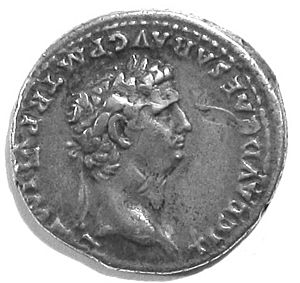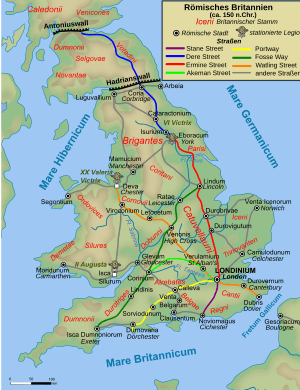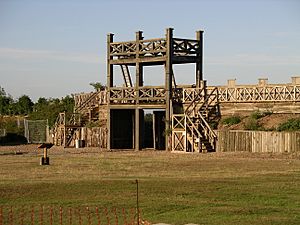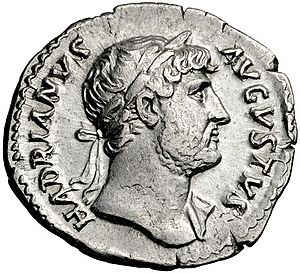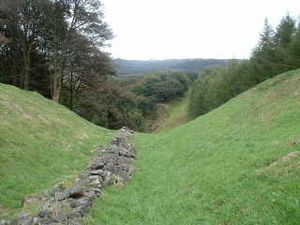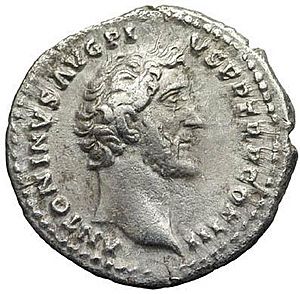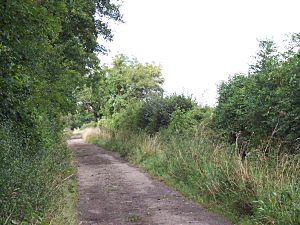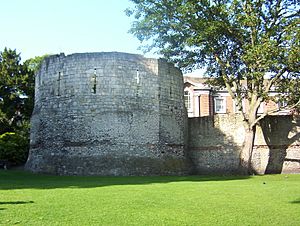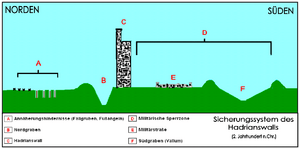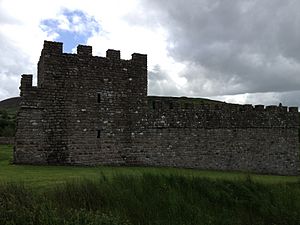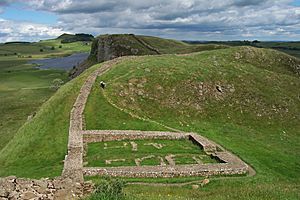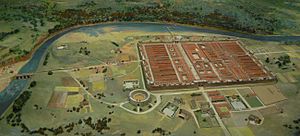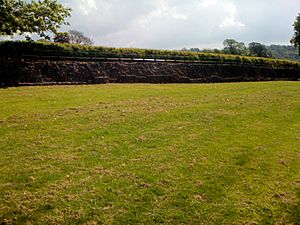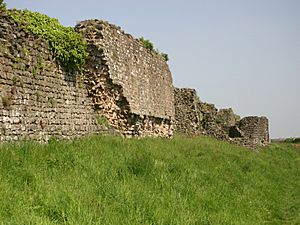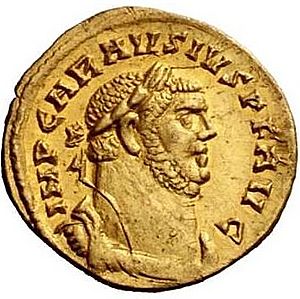Limes Britannicus facts for kids



The frontier of the Roman Empire in Britain is sometimes styled Limes Britannicus ("British Limes") by authors for the boundaries, including fortifications and defensive ramparts, that were built to protect Roman Britain (the term Limes is mainly and originally used for the Roman frontier in the Germanic provinces). These defences existed from the 1st to the 5th centuries AD and ran through the territory of present-day England, Scotland and Wales.
Britain was one of the most troubled regions in the European part of the Roman Empire and could only be secured by the Roman Army at considerable effort. Despite a rapid victory over the tribes in the south, which Claudius' field commander, Aulus Plautius, achieved in 43 AD for Rome, the resistance of the British was not completely broken for a long time afterwards. Nevertheless, the Romans succeeded in further consolidating their rule in the period that followed, although the troops stationed there were overburdened by having to defend Britain simultaneously on three fronts. The incursions of barbarians from the north of the island repeatedly caused serious problems. To the west and south, the Britannic provinces had to be defended against Hibernian and Germanic attacks. Against all odds, Britain was held for almost three centuries by the Roman Empire. In retrospect, the Roman domination of Britain is generally considered to be positive. For a long time there was peace and prosperity on the island. Behind the protection of Hadrian's Wall and that formed by the natural coastal boundaries to the east, south and west, the region we now know as England was heavily influenced by the achievements of Roman civilization. Hadrian's Wall and the castra on the Saxon Shore are still the most prominent symbols of Roman rule over Britain.
Troops
As resistance - at least in the south - largely subsided in the late 1st century, Britannia stood out among the other provinces for the next 300 years on account of its massive military presence. Until the middle of the 2nd century, 10-12% of the Roman army was stationed there (Exercitus Britannicus), although it only constituted 4% of the entire Empire. Legions, auxiliary cohorts and the fleet were commanded by the respective incumbent provincial governors.
At its peak, the Roman army in Britannia probably comprised 35,000 to 40,000 men. Such a high number of soldiers can only partly be explained by the stubborn resistance of the British against Roman occupation. It is conceivable that Britannia's location on the margins of the Empire was seen as the ideal place e.g. to permanently isolate and occupy those legions potentially inclined to unrest. Even their commanders, thelegati, were blamed on several occasions for their rebellious behavior.
Britain is surrounded by water, so it was not so easy to launch a rebellion against the emperor from there. Despite that, in 185 AD, 1,500 British lanciarii (javelin throwers) marched to the gates of Rome and murdered there the praetorian prefect of the Commodus, Tigidius Perennis, and his family. How the soldiers succeeded in freely penetrating to the heart of the Empire, without the imperial court taking appropriate countermeasures, remains a mystery even now. Perhaps those in Rome were too firmly convinced that troops in Britain were too far away to represent a serious threat. During the era of Gallic and British Empires in the 3rd century, the Britannic troops were always on the side of the usurpers.
Legions
In the first four decades after the invasion of 43, four legions were stationed in Britannia. Thereafter until the end of Roman rule, the number was reduced to three. Their headquarters were located in:
- Eburacum/York,
- Isca Silurum/Caerlon und
- Deva/Chester.
Taken together their total strength was around 15,000 men.
| Period | Legion | Bases/Operations |
|---|---|---|
| 1st to 5th centuries | Legio II Augusta | |
| 1st century | Legio II Adiutrix Pia Fidelis | |
| 2nd to 5th centuries | Legio VI Victrix Pia Fidelis | |
| 1st and 2nd centuries | Legio IX Hispana | |
| 1st century | Legio XIV Gemina Martia Victrix | |
| 1st to 3rd centuries | Legio XX Valeria Victrix |
Auxiliary troops
More than half the Roman occupation troops in Britannia were recruited as auxiliary units (auxilia). Auxiliary units were only rarely mentioned in ancient literary sources. Under Hadrian there were 14 regiments of cavalry (ala, each about 500 strong) and 45 battalions of infantry (cohortes peditae, each about 480 strong) making up the auxiliary forces:
- civium Romanorum = Roman citizens
- equitata = partly mounted
- milliaria = 1,000 men strong
| Cavalry | Mixed cavalry/infantry | Infantry | Infantry |
|---|---|---|---|
|
ala Augusta Gallorum Petriana milliaria civium Romanorum |
cohors I Augusta Nerviana Germanorum milliaria equitata |
cohors I Menapiorum |
cohors I Tungrorum milliaria |
Fleet
The provincial navy, Classis Britannica, was responsible for the monitoring and surveillance of the waters around the British Isles. It was initially drawn from the naval forces deployed in the invasion. Its units operated mostly in close cooperation with the ground forces and also had a key role in supplying the provincial army with the necessary materiel. They played an important role especially in the campaigns of Gnaeus Julius Agricola in the north of the island. Its crews teams explored the coasts of Ireland and Scotland and circumnavigated Britain. With the construction of the limes on the Saxon Shore in the 3rd century the fleet became more important again. Vegetius, a chronicler who published his works in the late 4th century, mentions the existence of the provincial fleet at this time. The main task of its warships was to secure the strategically and economically important passage between the British and Gallic coast, i.e. from Dover to Calais. Its main port on the British side was initially probably Dubris/Dobra (Dover). Under Carausius, the Fleet Command was temporarily based in Portus Adurni (Port Chester), after which it was transferred to Rutupiae (Richborough).
Literature
- Anthony R. Birley, The Roman government of Britain, Oxford University Press, 2005, ISBN: 978-0-19-925237-4.
- Anthony R. Birley, The people of Roman Britain, University of California Press, 1980, ISBN: 978-0-520-04119-6.
- Alan K. Bowman, Peter Garnsey, Dominic Rathbone (eds.): The Cambridge Ancient History. Vol. 11: The High Empire, A.D. 70-192. University Press, Cambridge, 2000, ISBN: 0-521-26335-2.
- Kai Brodersen, Das römische Britannien. Spuren seiner Geschichte. Primus, Darmstadt, 1998, ISBN: 3-89678-080-8.
- Geoff & Fran Doel, Terry Lloyd, König Artus und seine Welt. Ein Streifzug durch Geschichte, Mythologie und Literatur. Aus dem Englischen von Christof Köhler. 2nd edn. Sutton Verlag 2000, ISBN: 3-89702-191-9.
- A. Simon Esmonde-Cleary, The Ending of Roman Britain, Routledge, 1991, ISBN: 978-0-415-23898-4.
- Thomas Fischer, Die Armee der Caesaren. Archäologie und Geschichte. With contributions by Ronald Bockius, Dietrich Boschung and Thomas Schmidts. Verlag Friedrich Pustet, Regensburg, 2012, ISBN: 978-3-7917-2413-3.
- Sheppard Frere, Britannia: a history of Roman Britain, Routledge, 1987, ISBN: 978-0-7102-1215-3.
- Alexander Gaheis, "Iulius 49", Paulys Realencyclopädie der classischen Altertumswissenschaft (RE). Vol. X,1, Stuttgart, 1918.
- Alfred Michael Hirt, Imperial Mines and Quarries in the Roman World: Organizational Aspects 27 BC-AD 235 (Oxford Classical Monographs), Oxford University Press, Oxford, 2010, ISBN: 978-0-19-957287-8.
- Richard Hobbs, Ralph Jackson, Das Römische Britannien, Theiss 2011, ISBN: 978-3-8062-2525-9.
- Stephen Johnson, The Roman Forts of the Saxon Shore. 2nd edn.. Elek, London, 1979, ISBN: 0-236-40165-3.
- Stephen Johnson, Late Roman fortifications. Batsford, London 1983, ISBN: 0-7134-3476-7.
- Lawrence J. F. Keppie, Legions and veterans: Roman army papers 1971-2000 (Mavors. Roman Army Researches Band 12), Steiner, Stuttgart, 2000, ISBN: 978-3-515-07744-6.
- Margot Klee, Grenzen des Imperiums. Leben am römischen Limes. Konrad Theiss Verlag, Stuttgart, 2006, ISBN: 3-8062-2015-8.
- Wolfgang Kuhoff, Diokletian und die Epoche der Tetrarchie. Das römische Reich zwischen Krisenbewältigung und Neuaufbau (284–313 n. Chr.), Frankfurt am Main, 2001.
- Claude Lepelley (ed.), Rom und das Reich in der Hohen Kaiserzeit, Bd. 2: Die Regionen des Reiches, de Gruyter, Munich, 2001, ISBN: 3-598-77449-4.
- Simon McDowall, Gerry Embleton, Late Roman Infantryman, 236–565 AD. Weapons – Armour – Tactics. Osprey Military, Oxford, 1994, ISBN: 1-85532-419-9 (Warrior Series 9).
- John Morris, The Age of Arthur, Weidenfeld & Nicolson, London, 1973, ISBN: 0-297-17601-3.
- Victor Erle Nash-Williams, The Roman frontier in Wales, University of Wales Press, 2nd edn., Cardiff, 1969.
- National Museums & Galleries of Wales (ed.): Birthday of the eagle: the second Augustan legion and the Roman military machine, 2002, ISBN: 0-7200-0514-0.
- Peter Salway, History of Roman Britain, Oxford History of England, Oxford Paperbacks, 2001.
- Oliver Schmitt, Constantin der Große, Stuttgart and others, 2007.
- Matthias Springer, Die Sachsen. Kohlhammer Verlag, Stuttgart, 2004. ISBN: 3-17-016588-7
- Ronald Syme, Tacitus. Vol. 1 (of 2). Oxford 1958.
- Malcolm Todd, Julius Agricola, Gnaeus. In: Oxford Dictionary of National Biography (ODNB). Vol. 30 (2004).
- John Stewart Wacher, Coming of Rome (Britain Before the Conquest), Routledge, 1979, ISBN: 978-0-7100-0312-6.
- Alex Woolfe, Romancing the Celts: Segmentary societies and the geography of Romanization in the north-west provinces, in: Ray Laurence und Joanne Berry (eds.): Cultural Identity in the Roman Empire. Routledge, Oxford, 1998. ISBN: 0-203-02266-1
Images for kids
-
The North: reconstructed wooden tower in Vindolanda


